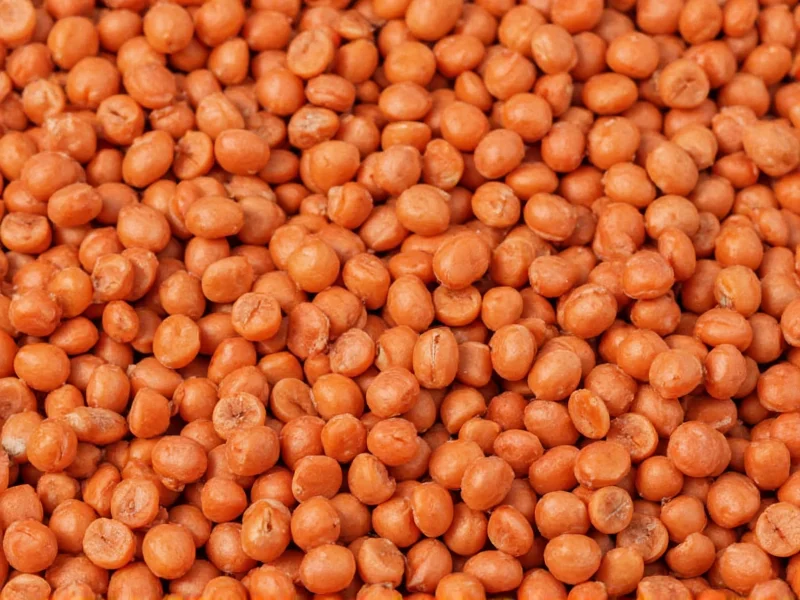Red lentils stand out among legumes for their impressive nutritional density and culinary versatility. These small, disc-shaped pulses deliver complete plant-based nutrition that supports multiple aspects of health. Understanding their specific nutritional profile helps maximize their benefits in your daily diet.
Nutritional Profile of Red Lentils
One cooked half-cup (99g) serving of red lentils contains these essential nutrients:
| Nutrient | Amount | % Daily Value |
|---|---|---|
| Calories | 115 | 6% |
| Protein | 9g | 18% |
| Dietary Fiber | 8g | 29% |
| Total Carbohydrates | 20g | 7% |
| Folate (B9) | 180mcg | 46% |
| Iron | 3.6mg | 20% |
| Manganese | 0.67mg | 29% |
| Potassium | 365mg | 8% |
Historical Evolution and Agricultural Timeline
Red lentils have evolved significantly from their ancient origins to modern cultivation. Archaeological evidence from the Fertile Crescent shows domestication beginning around 8000 BC, with early varieties being smaller and requiring longer cooking times. By 2000 BC, lentils spread across Mediterranean and South Asian civilizations, becoming dietary staples in Egyptian and Indus Valley cultures. The 20th century brought pivotal changes: Canadian agricultural research in the 1970s developed disease-resistant red varieties with thinner seed coats, reducing cooking time from 45 to 15 minutes. According to the Food and Agriculture Organization (FAO), global production surged from 1.8 million tons in 1990 to 6.2 million tons in 2022, driven by drought-tolerant hybrids suitable for climate-vulnerable regions. This timeline demonstrates how selective breeding transformed red lentils from a slow-cooking ancient grain to today's nutritionally optimized superfood.
Vitamins and Minerals Breakdown
Red lentils shine with their micronutrient density. Their folate content supports cellular function and is particularly important during pregnancy. The significant iron levels (non-heme iron) provide essential oxygen transport capabilities, though pairing with vitamin C-rich foods enhances absorption. Manganese contributes to bone health and metabolic function, while potassium helps regulate blood pressure.
Compared to other legumes, red lentils offer moderate levels of phosphorus and copper, plus smaller amounts of zinc, magnesium, and B vitamins. Their nutritional value per 100g makes them competitive with other plant proteins while providing unique micronutrient combinations.
Health Benefits of Red Lentils
The nutritional composition of red lentils translates to multiple evidence-based health advantages. Their high fiber content—particularly soluble fiber—helps regulate blood sugar levels, making them valuable for diabetes management. Research shows regular legume consumption can reduce LDL cholesterol by 5-10%, contributing to cardiovascular protection.
For weight management, red lentils provide substantial satiety due to their protein-fiber combination. Studies indicate people who include legumes in their diet maintain healthier body weights. The complex carbohydrates in red lentils have a moderate glycemic index (around 29-32), preventing blood sugar spikes compared to refined grains.
Red Lentils vs Other Lentil Varieties
Understanding red lentils nutrition requires comparison with other varieties. While all lentils share core nutritional benefits, differences exist:
- Red lentils cook fastest (15-20 minutes), have slightly higher carbohydrates, and lower fiber than green varieties
- Green/brown lentils maintain shape better when cooked and contain marginally more fiber
- Black (Beluga) lentils offer the highest antioxidant content but require longer cooking
- Puy lentils have a firmer texture and slightly different mineral profile
When evaluating red lentils protein content compared to meat, they provide comparable protein per calorie while adding fiber and complex carbohydrates that animal proteins lack. However, they require complementary proteins (like grains) to form complete amino acid profiles.
Cooking Methods and Nutrient Preservation
How you prepare red lentils affects their nutritional value. Boiling preserves most nutrients, though water-soluble vitamins like folate can leach into cooking water. Using the cooking liquid in soups or stews captures these nutrients. Pressure cooking red lentils maintains more nutrients than extended boiling.
Avoid adding salt during cooking, as it can toughen lentils and potentially reduce nutrient availability. Soaking isn't necessary for red lentils due to their thin skins, but rinsing removes debris. For maximum nutrient retention when cooking red lentils, use minimal water and avoid overcooking.
Incorporating Red Lentils Into Your Diet
Red lentils' quick cooking time and mild flavor make them versatile. They work well in:
- Creamy soups and dals (they break down easily)
- Vegetarian burgers and meat substitutes
- Salads when slightly undercooked for texture
- Baked goods as partial flour replacement
- Breakfast porridges with spices and fruits
For those exploring red lentils for digestion benefits, start with smaller portions to allow your system to adjust to the increased fiber. Pairing with digestive spices like cumin or ginger can minimize potential gas production while enhancing flavor.
Contextual Limitations and Dietary Boundaries
While generally beneficial, red lentils have specific contextual limitations requiring careful consideration. For chronic kidney disease (CKD) patients, the high potassium content (365mg per half-cup) may necessitate restriction; the National Kidney Foundation advises individualized meal planning with a registered dietitian to manage potassium intake (source). Similarly, individuals managing gout should monitor portions as lentils contain moderate purine levels (50-150mg per 100g), though they pose lower risk than organ meats according to National Institute of Arthritis and Musculoskeletal and Skin Diseases guidelines (source).
General considerations include potential digestive discomfort from oligosaccharides, which proper preparation minimizes. Those with legume allergies must avoid red lentils entirely. Phytic acid content decreases significantly with cooking but may affect mineral absorption in populations with marginal nutrient status—pairing with vitamin C-rich foods enhances iron uptake. Unlike soy, red lentils contain negligible goitrogens, making them generally suitable for thyroid health.
Conclusion
Red lentils represent one of the most nutritionally efficient plant foods available. Their balanced macronutrient profile, rich micronutrient content, and versatility make them valuable for nearly all dietary patterns. Whether you're exploring red lentils nutritional value for weight loss, heart health, or simply expanding your plant-based options, these legumes deliver substantial benefits with minimal preparation requirements.











 浙公网安备
33010002000092号
浙公网安备
33010002000092号 浙B2-20120091-4
浙B2-20120091-4